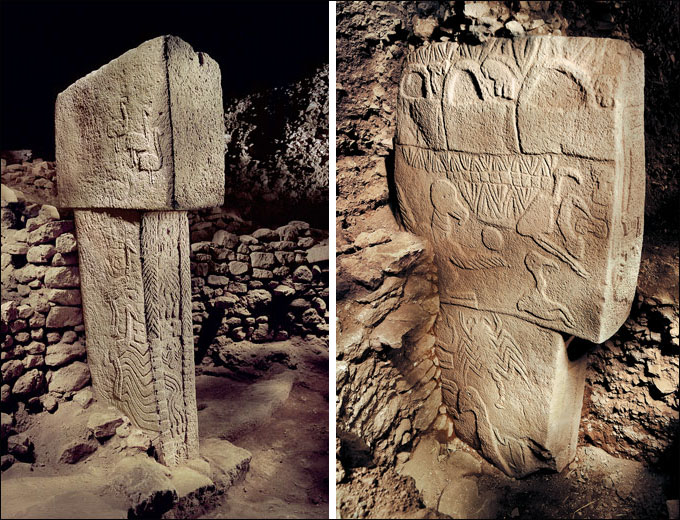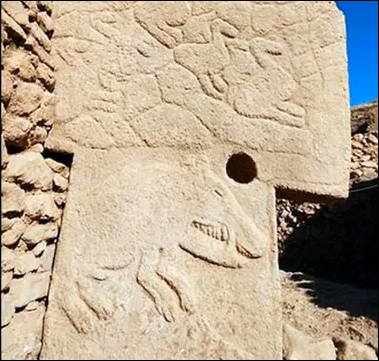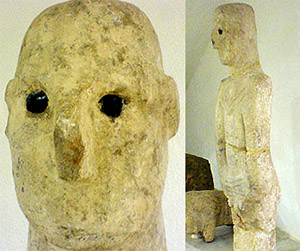 | ||||
|
|
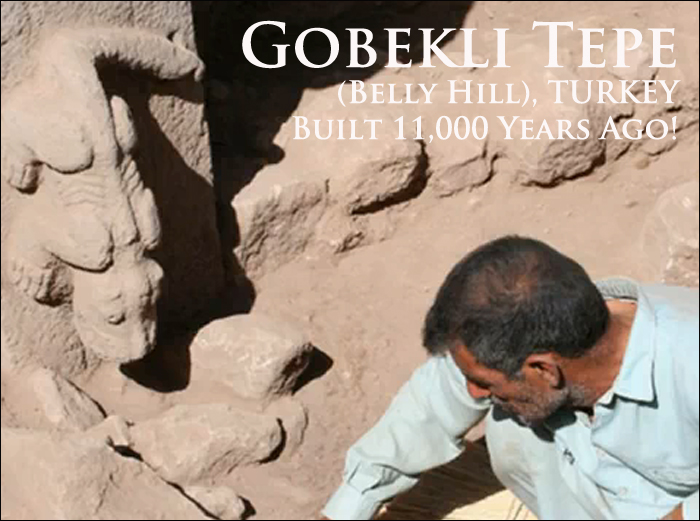
by Gary Vey for viewzone
So often we think of primitive humans as being crude and clumsy, grunting to each other while wearing animal skins and living in caves. We see them as reactive -- struggling against nature and barely winning the battles to survive. While this is true for much of human antiquity, around 9000 BC something dramatic happened. It was the beginning of the era when man became proactive -- he took control of his environment and destiny. We don't know exactly why this happened, but we have some clues. One interesting theory comes from psychologist Julian Jaynes who suggests that the human mind divided itself into two different types of thinking, each processing its thoughts in a separate hemisphere of the brain. One side processed logic, details, facts, and strategies (usually the left) while the other processed emotions, symbols, language and future planning. In his book, The Origin of Consciousness in the Breakdown of the Bicameral Mind, Jaynes places this dramatic event around 3000 years ago. But recent discoveries, like the one in Turkey at Gobekli Tepe, have pushed this event back to more than 11,000 years ago. One small step for man. One giant step for mankind. Prior to this division of labor in the human mind, thoughts and ideas were largely in the "here and now." Civilization advanced slowly by repeating successful behaviors and strategies. Attention was paid to patterns, especially where these related to food. Certain seasons brought various types of migrating animals which could be hunted. Ripe fruits were plentiful in certain regions at specific times of the year -- measured by the number of full Moons that passed or the position of the Sun against a mountain.
 The earliest calendar was found in Uganda [above] and dates to this period. Some sites in North America suggest that the Clovis culture had stone alignments to measure the positions of the Sun, marking the seasonal climate changes. Early humans were hunters and gatherers, always on the move, with few opportunities to plan for the future, decorate their bodies or dwellings or build communities. But that suddenly changed 11,000 years ago. With part of the human brain assigned to look at the world in new ways, the idea of growing one's food instead of hunting or foraging for it was invented. With the development of future thinking, planting seeds and the domestication of animals for milk, eggs and meat allowed for stable communities to grow. With this came the much needed socialization and the sharing of ideas that led to what we call civilization. In another article on viewzone, we showed dramatic evidence that the remains of what is believed to be Noah's Ark has been located in Turkey, near the Iranian border. Certainly a large and somewhat petrified hull of a boat is there, causing historians and religious leaders to re-evaluate their paradigms. And so it is no surprise that we should find yet another apparent anomaly in the same general area. 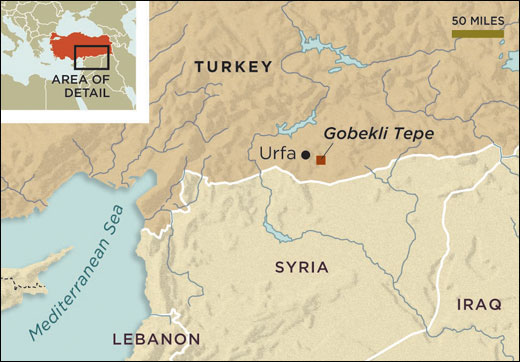 This evolved division of human thought processing is no more evident than at the archaeological site of Gobekli Tepe, located just North of the Syrian border with Turkey. Here we see evidence of a real community where groups of people worked together to create shelters with architectural design, a balance of form and function, and for an abstract spiritual purpose. The influence of the right brain is very evident. But even more remarkable are the artistic elements found inside these shelters.
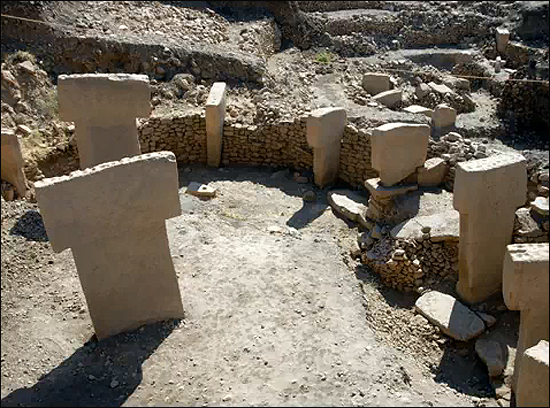 The shelters are well designed. The "T" shape stones have been carved from a quarry about a kilometer away and weigh about 20 tons each. It is estimated that at least 500 workers would have had to be involved in carving and moving these huge stones. The stones are actually pillars used to support a roof, probably made of wood. Arranged in a circle and spaced by about 2 to 4 meters apart, the pillars are part of the walls of the shelter which were finished by piling stones between them. Many of these stone walls have been found intact. 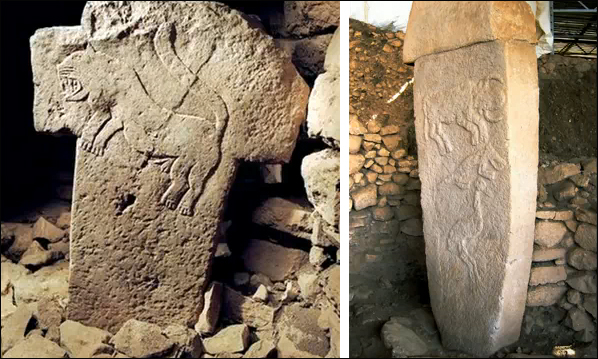 The stone pillars are amazing examples of what artists call bas relief. To make a bas relief sculpture you have to think in the abstract. An artist friend of mine begins his sculptures by approaching a solid material and asking the question, "what's in there?" In his thinking, the carved shape already exists and his task is to take away the material surrounding it. It's a kind of "negative" thinking that requires the special cognitive and creative abilities of the right brain. The same type of thinking was required to make arrow points, such as the Clovis, from flint. And this ability was suddenly and mysteriously available to virtually all human minds around 9000 BC.
Background and History of the site Gobekli Tepe is located on the top of a small hill. The name means "hill with a navel" or "hill with a belly" in Turkish. In the 1960's an archeologists from the University of Chicago examined the site as part of a general survey of the region. There were some ruins of an old monestery on the site and, at the time, no real effort was made to look for anything with great antiquity. In the 1990s a local shepherd noticed some obviously carved stones peaking through the ground and alerted the authorities. Word spread to the German Archeological Institute in Istanbul and a man named Klaus Schmidt re-visited the site in 1994. He collected some artifacts at the site and saw the similarity between these and some museum pieces that had been dated to 9,000 BC. Soon, a German-Turkish team was excavating the site.
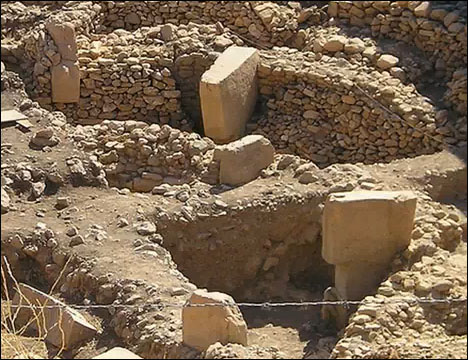 The entire site covers 22 acres. The top of the hill is somewhat flat with a "bump" of about 300 meters in diameter and 15 meters high which seemed to contain the mother load of the archaeological material. Only about one acre has been examined so far. The site appears to be dated mostly from about 9,000 BC and 8,000 BC, but other artifacts on the site have been dated to between 11,000 BC and 12,000 BC. This era lies on the cusp of the hunter-gatherer and agricultural epochs. It seems to have been built just as humanity had evolved to utilize its two brains. Klaus Schmidt, the chief archeologist of Gobekli Tepe speculates that hunter-gatherer bands or tribes lived near the site in animal skin tents and built the complex over several decades. So far, however, no concrete evidence has been found to demonstrate that the builders engaged in farming of animal herding. In fact, there are a large number of microflint arrowheads found near the site. Also bones of wild animals surround the site, many of them bearing marks indicating that the animals were butchered. This suggests that the evolution of agriculture and animal husbandry was in the process of being developed. There are seven round structures on the site, ranging from about 10 to 30 meters in diameter. So far only 4 have been excavated. Ground scanning data shows at least 16 more buildings remain burried in the hill, consisting of about 200 additional T-shaped pillars. Each shelter has outside pillars standing about 6 feet high with central pillars of about 9 to 10 feet tall. Almost all of these pillars are decorated with animals in bas relief depicting vultures, foxes, lions, cattle, wild boars, scorpions, ants and snakes. There are also a number of free-standing sculptures, badly damaged and encrusted with lime, which probably also represent animals. The floors are made of burnt lime (terrazzo) and there is a low bench running around the inside of the outer walls.
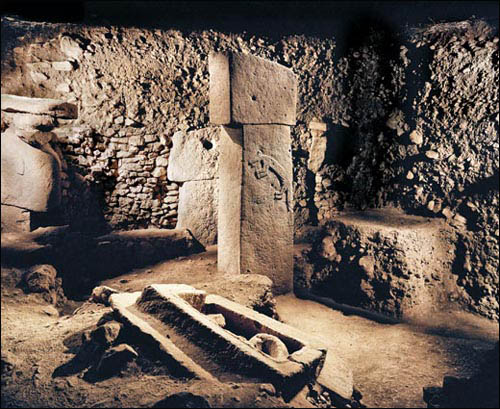 Oddly, there is no evidence that people ever lived in the shelters. There are no cooking hearths, bones or garbage. This, along with the vulture totems, has led many to believe the site had some religious purpose. Although no graves have been found, it has been suggested that the site was possibly a type of cemetery for the dead. Human remains have been found outside the perimeter of the site. This suggests that humans may have been buried or left in the open air to be eaten by animals. This would reinforce the vulture totem found carved on the pillars. Some paradoxes at the site The site shows two eras of construction, separated by thousands of years. The oldest era, starting around 11,000 years ago, contains the most elaborate carvings and attention to detail. But advance a couple of thousand years and the workmanship deteriorates! More practical and basic designs are utilized with little or no decorations. Obviously, we would expect the opposite to be true -- especially for a site that was so important to have been in use for several thousand years! The other paradox in that around 8000-7500 BC, Gobekli Tepe was deliberately covered with about 300-500 cubic meters of soil, and abandoned. The reason for the abandonment is unknown.
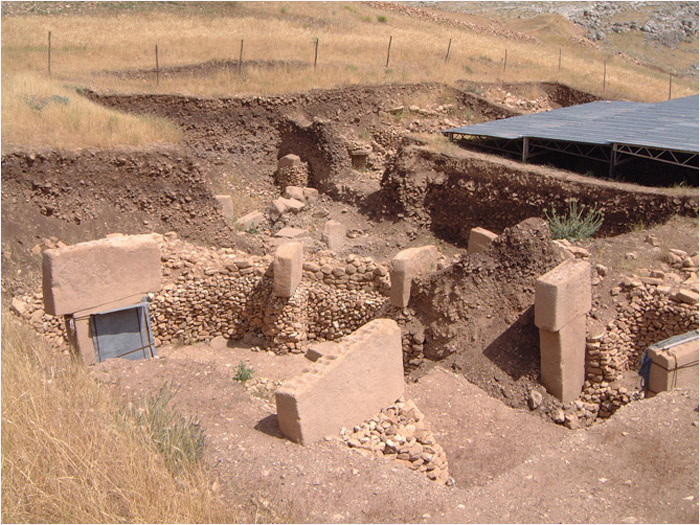 Agriculture and Animal Husbandry 10,500 years ago, agriculture originated in the hills around Gobekli Tepe. Archaeological evidence shows that wheat was grown and harvested, as well as other indigenous plants. Animals such as sheep, cattle and pigs were herded and used for their milk and meat. Dogs and cats were domesticated and probably used for pest control or to protect the harvest from rodents or thieves. An old man was even found buried with his canine companion. All of this was made possible by right-brain processing which involves emotion and future planning. The Arts
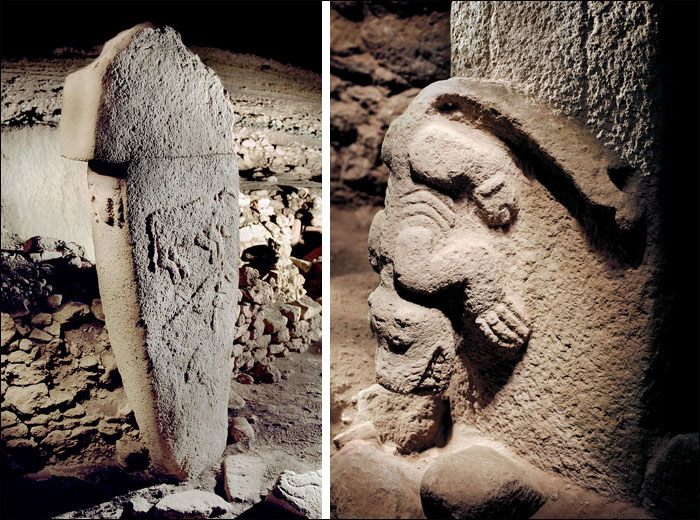
Besides the refined and beautiful bas reliefs of various animals in the shelters, the oldest full-size human statue was found in the area. It consists of a full size man carved from limestone with obsidian eyes. Tests show it is 12,000 years old. Garden of Eden? Some Biblical scholars have also associated Gobekli Tepe with the myth of Eden. According to this interpretation, the myth refers to the transition from a hunter-gatherer society to one based on agriculture. The thinking is that the hunting-gathering lifestyle was easy and pleasant, at least in areas that were rich in resources. Agriculture, by contrast, involved a lot of work and was probably not very productive to begin with. The loss of Eden was the transition to agriculture, and may be a memory of what happened at Gobekli Tepe. God says to Adam:
Another analogy can be made for the division of the human brain, suddenly capable of having two thoughts at the same time:
You can read more about your left and right brain and their unique ways of looking at the world in Dan Eden's wonderful article, Left Brain : Right Brain on viewzone.
 Comments: Please check out the Great Year/ Yuga Cycles of time. We in the west are convinced time runs in a linear fashion supported by Modern day scientists, aka the Theory of Evolution along with Church dogma. All ancient cultures understood time as cycles/ hoops. Let’s not forget the 5,200 cycle of time that may have brought down cultures like this with some kind of catastrophic event. Rumor has it; it may be that time again (2012). Gary H.
Dear Gary, this old site in Turkey, and some preliminary conclusions and observations that you have recollected in this article, certainly merit another angle. Since we are speculating about a major division in man's ("mainstream view") development (from brute to hypocrite), which seems utterly inadequate (or willfully manipulated) to explain several hair-raising inconsistencies that go beyond the merely technical or scholarly dispute, let's have a look. "God knows well that the moment you eat of it your eyes will be opened and you will be like gods who know what is good and what is bad." --Genesis 3:5 If we had our dear Terence McKenna with out, he would rightfully point out that for someone to be "like gods" can (and does) mean that there is something you can eat that will make you like (a) god. And sure enough, it grows on dung and belongs to the coprophilic Psylocybe and Stropharia genus. A major dose of them (five dried grams) WILL make you like a god (whatever that is), and you can bet your derriere on it. And it is repeatable. Besides the advantages that low and medium doses confer to the human realm (highly increased visual accuity for hunters trying to spot game, and serious sexual and general CNS arousal, respectively), a full-blown psychedelic trip is most certainly what brings us to be like gods. Just ask anyone who has done so, or read about it. For a while at least, it delivers as promised - it would be unbearable as a continuum (or ... would it?). Of course Terence McKenna was not taken "seriously" by "serious science", since his well-documented foray to explain modern human consciousness and other hot topics was centered around a so-called "Schedule One" substance that gets you serious jail time. Now, admitting that this thingy had something to do with what we are, or were, or how we got to where we are now (mostly due to its suppression), that is just not practical for "them". Them, yes. Those that brought you Climate Warming caused by humans. And cool solutions to a financial crisis (throw fictitious money at it but never say where it went). And wonderful poop culture, the sidekick of the techonotronic society (right, Zbig?). Those who tried to sell you Einstein and Darwin as the absolutely last words (more of a babble - check Nassim Haramein and Rupert Sheldrake for updates on those two "science monsters"). "Those scientists", who likely have to do drug tests to get their position, did and can not look into the obvious connection between and overdose of the brain on substances it loves and wants and actually produces, in the form of a humble mushroom, and becoming like a god. Let them not fool you, the early humans were psychedelic, just like the shamans who guided them. In the absence of the real deal mushroom (or Ayahuasca, or Iboga, Cannabis and Mescaline), the original shamanism resorts to trade-offs and mumbo jumbo. But the original experience is always there for those who are prepared for it. And compared to the rather lame 60's, the psychedelic culture today is orders of magnitude more prevalent and sophisticated. They won't drag us out of Eden again to build stuff for them rather than stay where we feel fine! We seem to be governed by some privileged placeholders of the original "Gods" who genetically engineered us, in their image. But we were of no use for them, us being stoned and running after game while the women collected yummy things on the way. We had to settle the f*&% down to do some work for "them". Always the same: they eat and you work. So. Gobekli Tepe could be a window to this transition, certainly not the first one in mankind's history, just the most recent one. Check Michael Cremo and "Forbidden Archaeology". Gobekli Tepe was originally built with much creativity - out of nowhere. Couple thousand years later, the art put into it rather sucks. Devolution rather than evolution. Give it a thought in your bicameral mind. idiot savant
| |||
 The region was not as dry and baron as it looks today. Many small animals and birds were readily available as food sources and these crude but sharp stones were used as arrow and spear points as well as cutting and scraping tools. The tools were not very sophisticated but they were sharp and could be made easily as needed from material in the environment.
The region was not as dry and baron as it looks today. Many small animals and birds were readily available as food sources and these crude but sharp stones were used as arrow and spear points as well as cutting and scraping tools. The tools were not very sophisticated but they were sharp and could be made easily as needed from material in the environment.